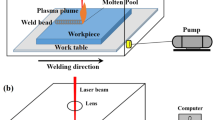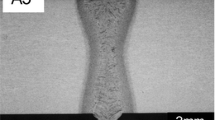Abstract
In order to elucidate the effects of phase transformation on distortion and residual stress generated by laser beam welding (LBW) on high-strength steel (HT780), a one-pass bead-on-plate welding experiment was carried out. Then, the experiment was simulated by the thermal elastic-plastic analysis. Because the mechanical properties in the phase transformation range could not be specified, they were idealized while considering the transformation expansion and the transformation superplasticity in the simulation of the experiment. The validity of the treatment of the mechanical properties in the phase transformation range was verified. It was elucidated that welding distortion and residual stress were largely affected by the phase transformation in the cooling process, although the bead width of LBW was extremely narrow, Angular distortion and tensile residual stress in the weld metal were largely released by the phase transformation.
Similar content being viewed by others
References
Inose K., Lee J.-Y., Nakanishi Y. and Kim Y.-C.: Characteristics of welding distortion/residual stress generated by fillet welding with laser beam and verification of generality of its high accurate prediction, Quarterly Journal of The Japan Welding Society, 2008, vol. 26, no. 1, pp. 61–66 (in Japanese).
Ueda Y., Kim Y.-C., Chen C. and Tang Y.-M.: Mathematical treatment of phase transformation and analytical calculation method of restraint stress-strain, Quarterly Journal of The Japan Welding Society, 1984, vol. 2, no. 1, pp. 89–97 (in Japanese).
Kim Y.-C., Hirohata M. and Hageyama Y.: Modeling of phase transformation in cooling process and verification of its validity, International Conference on High Strength Steels for Hydropower Plants, Takasaki, Japan, 2009, pp. 1–4.
Kim Y.-C., Lee J.-Y. and Inose K.: Determination of dominant factors in high accuracy prediction of welding distortion, Doc. IIW-2004, Welding in the World, 2010, vol. 54, no. 7/8, pp. R234–R240.
Lee J.-Y., Inose K. and Kim Y.-C.: Verification of validity and generality of dominant factors in high accuracy prediction of welding distortion, Doc. IIW-2005, Welding in the World, 2010, vol. 54, no. 9/10, pp. R279–R285.
Vetrano J.S.: Superplasticity: Mechanisms and application, JOM, Journal of the Minerals, Metals and Materials Society, 2001, vol. 53, no. 3, p.22–22.
Author information
Authors and Affiliations
Corresponding author
Additional information
Joining and Welding Research Institute, Osaka University
Rights and permissions
About this article
Cite this article
Kim, YC., Hirohata, M. & Inse, K. Effects of Phase Transformation on Distortion and Residual Stress Generated by Laser Beam Welding on High-Strength Steel. Weld World 56, 64–70 (2012). https://doi.org/10.1007/BF03321336
Published:
Issue Date:
DOI: https://doi.org/10.1007/BF03321336




